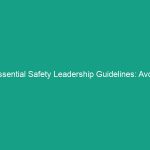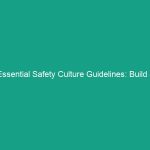Good Morning Team!
Today, we’re going to discuss a crucial topic that impacts our daily operations and overall Safety: Essential Temporary Stairs and Handrails Guidelines to Avoid Risks. Understanding and implementing these guidelines is vital to ensure everyone returns home safe and sound.
Understanding Essential Temporary Stairs and Handrails
Temporary stairs and handrails are often used in construction and Maintenance projects to provide safe access to elevated areas. These structures must be sturdy, secure, and compliant with Safety Regulations to prevent falls and injuries.
Ignoring the importance of these guidelines can lead to severe accidents, injuries, and even fatalities. It’s essential to understand how temporary staircases and handrails can impact our work Environment and the safety of our colleagues.
Key Hazards, Risks, and Safety Considerations
When it comes to temporary stairs and handrails, several Hazards can arise, including:
- Poorly constructed or unstable stairs
- Inadequate handrails or lack of handrails
- Slippery surfaces on stairs
- Improper load capacity
- Obstructions on stairways
Ignoring these hazards can lead to serious consequences. For instance, a worker could sustain a debilitating injury from a fall due to a lack of proper handrails. By recognizing these risks, we can take proactive measures to mitigate them.
Best Practices, Procedures, & Actionable Advice
To ensure the safety of temporary stairs and handrails, here are some Best Practices to follow:
1. Ensure Proper Construction
Temporary stairs must be built using high-quality materials and designed to withstand expected loads. Ensure:
- Stairs are built at an appropriate angle (not steeper than 4:1 ratio).
- Each step is uniform in height and depth, with no sudden changes.
- Materials used are free from defects and suitable for the environment.
2. Install Handrails Correctly
Handrails are critical for providing support and preventing falls. Ensure:
- Handrails are installed on both sides of the stairs.
- They are at a height of 30 to 34 inches, depending on regulations.
- Handrails must be continuous, without any breaks.
- They should be made of strong materials that can bear weight.
3. Maintain a Clean and Clear Stairway
Ensure that stairways are kept free of debris, tools, and equipment. A clear path can prevent trips and falls.
4. Conduct Regular Inspections
Regularly inspect temporary stairs and handrails for wear and tear. Check for:
- Loose steps or railings.
- Signs of damage or corrosion.
- Compliance with safety Standards.
5. Train Employees on Safety Protocols
Training is crucial. Make sure every employee understands:
- How to use temporary stairs and handrails safely.
- The importance of reporting hazards immediately.
- Basic first aid Procedures in case of an accident.
Regulations, Standards, and Compliance
Compliance with safety regulations is not just a legal requirement but also a moral obligation to protect our workforce. Here are some key standards to keep in mind:
- OSHA 1926.1052 – Stairways and Ladders
- osha 1910.23 – Guarding Floor and Wall Openings and Holes
- ANSI A14.7 – American National Standard for Portable Metal Ladders
Understanding and adhering to these regulations can significantly reduce the risk of accidents and enhance Workplace Safety.
Employee Engagement & Discussion
Let’s take a moment to reflect on our own experiences. What safety challenges have you encountered related to temporary stairs and handrails? Have you noticed any areas for improvement? Your insights are invaluable, and discussing these issues can lead to better safety practices.
Conclusion & Key Takeaways
In summary, the safety of temporary stairs and handrails cannot be overstated. By following the guidelines outlined above, we can significantly reduce risks and ensure a safer workplace for everyone. Remember:
- Construct stairs properly and ensure handrails are installed securely.
- Maintain a clean and clear stairway to prevent accidents.
- Regularly inspect for hazards and train everyone on safety protocols.
Thank you all for your attention and commitment to safety. Let’s make it a priority to implement these practices and look out for one another!


